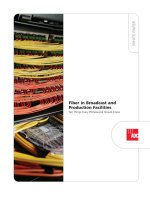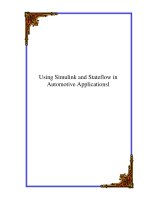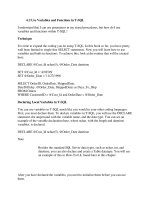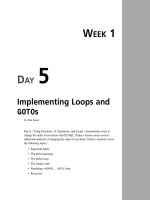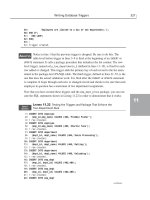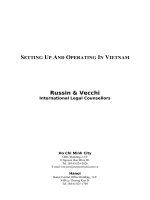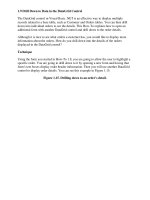Tài liệu Allergic disease and sensitization in Steiner school children pptx
Bạn đang xem bản rút gọn của tài liệu. Xem và tải ngay bản đầy đủ của tài liệu tại đây (268.92 KB, 8 trang )
Allergic disease and sensitization in
Steiner school children
Helen Flo¨ istrup, MSc,
a,b
Jackie Swartz, MD,
c
Anna Bergstro¨ m, PhD,
a
Johan S. Alm, MD, PhD,
d
Annika Scheynius, MD, PhD,
e
Marianne van Hage, MD, PhD,
f
Marco Waser, PhD,
g
Charlotte Braun-Fahrla
¨
nder, MD,
g
Dieneke Schram-Bijkerk, MSc,
h
Machteld Huber, MD,
i
Anne Zutavern, MD,
j
Erika von Mutius, MD,
j
Ellen U
¨
blagger, MD,
k
Josef Riedler, MD, PhD,
l
Karin B. Michaels, ScD, PhD,
m
Go¨ ran Pershagen, MD, PhD,
a,n
and the PARSIFAL Study Group
o
Stockholm and
Ja¨rna, Sweden, Basel, Switzerland, Utrecht and Driebergen, The Netherlands, Munich
and Schwarzach, Germany, Salzburg, Austria, and Boston, Mass
Background: The anthroposophic lifestyle has several features
of interest in relation to allergy: for example, a restrictive use
of antibiotics and certain vaccinations. In a previous Swedish
study, Steiner school children (who often have an anthro-
posophic lifestyle) showed a reduced risk of atopy, but
specific protective factors could not be identified.
Objective: To investigate factors that may contribute to the
lower risk of allergy among Steiner school children.
Methods: Cross-sectional multicenter study including 6630
children age 5 to 13 years (4606 from Steiner schools and
2024 from reference schools) in 5 European countries.
Results: The prevalence of several studied outcomes was lower
in Steiner school children than in the reference group. Overall,
there were statistically significant reduced risks for
rhinoconjunctivitis, atopic eczema, and atopic sensitization
(allergen-specific IgE $0.35 kU/L), with some heterogeneity
between the countries. Focusing on doctor-diagnosed disease,
use of antibiotics during first year of life was associated with
increased risks of rhinoconjunctivitis (odds ratio [OR], 1.97;
95% CI, 1.26-3.08), asthma (OR, 2.79; 95% CI, 2.03-3.83), and
atopic eczema (OR, 1.63; 95% CI, 1.22-2.17). Early use of
antipyretics was related to an increased risk of asthma (OR,
1.54; 95% CI, 1.11-2.13) and atopic eczema (OR, 1.32; 95% CI,
1.02-1.71). Children having received measles, mumps, and rubella
vaccination showed an increased risk of rhinoconjunctivitis,
whereas measles infection was associated with a lower risk
of IgE-mediated eczema.
Conclusion: Certain features of the anthroposophic lifestyle,
such as restrictive use of antibiotics and antipyretics, are
associated with a reduced risk of allergic disease in children.
(J Allergy Clin Immunol 2006;117:59-66.)
Key words: Allergy, anthroposophic lifestyle, antibiotics, antipy-
retics, asthma, biodynamic diet, measles, sensitization, vaccination
The prevalence of IgE-mediated allergic diseases has
increased markedly during the past decades, especially
in children,
1,2
although recent reports indicate that the
occurrence has stabilized.
3
The causes behind these trends
are largely unknown. Factors increasing the risk have re-
ceived the greatest attention, but in recent years, attention
has also focused on possible protective factors, such as liv-
ing on a farm
4
and specific probiotic strains.
5
To identify
protective factors, it is of interest to study groups in the
population with a low prevalence of allergy, such as chil-
dren from anthroposophic families.
6
The anthroposophic
lifestyle includes factors like a restrictive use of antibi-
otics, antipyretics, and vaccinations, and often a biody-
namic diet.
6
An earlier study was conducted in a limited
community of anthroposophic families, showing a lower
prevalence of childhood allergy,
6
but specific protective
factors could not be identified.
The aim of this study was to identify possible protective
factors for allergy associated with the anthroposophic
lifestyle. The study subjects include school children from
Steiner schools, who often come from anthroposophic
From
a
the Institute of Environmental Medicine, and
b
the Centre for Allergy
Research, Karolinska Institutet, Stockholm;
c
the Vidar Clinic, Ja¨rna;
d
Sachs’ Children’s Hospital, Stockholm So¨der Hospital;
e
the Department
of Medicine, Clinical Allergy Research Unit, and
f
the Department of
Medicine, Clinical Immunology and Allergy Unit, Karolinska Institutet
and University Hospital, Stockholm;
g
the Department of Environment and
Health, Institute of Social and Preventive Medicine, University of Basel;
h
the Institute for Risk Assessment Sciences, Utrecht University;
i
the
Louis Bolk Institute, Driebergen;
j
Dr von Hauner Children’s Hospital,
University of Munich;
k
the Department of Paediatric Pulmonology and
Allergology, Children’s Hospital, Salzburg;
l
Children’s Hospital
Schwarzach;
m
Brigham and Women’s Hospital, Harvard Medical School,
and Department of Epidemiology, Harvard School of Public Health,
Boston, and and
n
the Department of Occupational and Environmental
Health, Stockholm County Council.
o
Go¨ ran Pershagen, Tobias Alfve´n, Johan Alm, Anna Bergstro¨ m, Lars
Engstrand, Helen Flo¨istrup, Marianne van Hage, Niclas Ha˚kansson,
Gunnar Lilja, Fredrik Nyberg, Annika Scheynius, Jackie Swartz, Magnus
Wickman (Sweden); Charlotte Braun-Fahrla¨nder, Marco Waser, Felix
Sennhauser, Roger Lauener, Johannes Wildhaber, Alex Mo¨ller
(Switzerland); Bert Brunekreef, Dieneke Schram-Bijkerk, Gert Doekes,
Mirian Boeve, Jeroen Douwes, Machteld Huber, Mirjam Matze (The
Netherlands); Erika von Mutius, Marcus R. Benz, Jo¨ rg Budde, Markus
Ege (Germany); Josef Riedler, Waltraud Eder, Ellen U
¨
blagger, Gertraud
Weiss, Mynda Schreuer (Austria); Karin B. Michels (United States).
Supported by a research grant from the European Union, QLRT 1999-01391,
and by funding from the Swedish Foundation for Health Care Science
and Allergy Research.
Received for publication May 10, 2005; revised September 8, 2005; accepted
for publication September 12, 2005.
Available online November 29, 2005.
Reprint requests: Helen Flo¨ istrup, MSc, Institute of Environmental Medicine,
Box 210, Karolinska Institutet, SE-171 77 Stockholm, Sweden. E-mail:
0091-6749/$32.00
Ó 2005 American Academy of Allergy, Asthma and Immunology
doi:10.1016/j.jaci.2005.09.039
59
Asthma diagnosis and
treatment
Abbreviations used
MMR: Measles, mumps, and rubella
OR: Odds ratio
PARSIFAL: Prevention of Allergy—Risk Factors for
Sensitization Related to Farming and
Anthroposophic Lifestyle
families, and reference children in 5 European countries,
constituting the largest and most coherent study ever per-
formed in this group of children.
METHODS
This work is based on the Prevention of Allergy—Risk Factors for
Sensitization Related to Farming and Anthroposophic Lifestyle
(PARSIFAL) study, a cross-sectional, multicenter study performed
in 5 European countries among children age 5 to 13 years. The design
has been described in detail elsewhere.
7
This report focuses on chil-
dren attending Steiner schools, as well as referents from non-Steiner
schools in similar regions. Information about environmental expo-
sures, history of infections, diet, animal contact, anthroposophic life-
style, and symptoms and diagnoses of allergic diseases was collected
through a parental questionnaire. Most of the questions were based on
the internationally standardized and validated International Study of
Asthma and Allergies in Childhood (ISAAC) phase II protocol,
8
or
derived from the earlier Swedish study on anthroposophic children.
6
The fieldwork was performed between October 2000 and May 2002
during overlapping periods in the different countries. The study was
approved by local ethics committees in all centers.
A venous blood sample was obtained from children with a
completed questionnaire and parental consent. Because of a large
number of children included in the questionnaire surveys in Germany
and Switzerland, a random sample of eligible children was selected in
these countries. In Germany, only Steiner school children whose
parents expressed an anthroposophic lifestyle were chosen for blood
sampling. Sera were stored at 220°C before analysis. Allergen-
specific IgE was measured against a mixture of common inhalant
(Phadiatop) and food (fx5) allergens (Pharmacia CAP System;
Pharmacia Diagnostics AB, Uppsala, Sweden). All IgE analyses
were performed at the Department of Clinical Immunology at the
Karolinska University Hospital, Stockholm, Sweden.
All health outcomes were reported by the parents, except sensi-
tization, which was assessed from blood sampling. Current rhino-
conjunctivitis symptoms were defined as sneezing, runny nose, nasal
block-up, and itchy eyes in the child during the last 12 months
without having a cold at the same time. Children diagnosed with hay
fever and who ever had symptoms of hay fever were considered to
have a doctor’s diagnosis of rhinoconjunctivitis. Current wheezing
was defined as having wheezing at least once during the last 12
months. Children ever diagnosed with asthma, or obstructive bron-
chitis more than once, were considered to have doctor’s diagnosis of
asthma. Current atopic eczema symptoms were present if the child
ever had had an itchy rash intermittently for at least 6 months, and if
the child had had this rash at any time during the last 12 months.
Children with an intermittent itchy rash for at least 6 months and who
had ever been diagnosed with atopic eczema were considered to have
a doctor’s diagnosis of atopic eczema. Atopic sensitization was
indicated if the child had at least 1 allergen-specific IgE result of
0.35 kU/L against common inhalant and/or food allergens. To
achieve a stricter definition of allergic disease, some analyses were
performed combining the symptom or doctor’s diagnosis–based
outcomes with IgE sensitization.
9
The relation between factors associated with the anthroposophic
lifestyle and health outcomes was estimated by using odds ratios
(ORs) and 95% CI, computed from logistic regression. Statistical
significance was calculated by the Pearson x
2
test statistic and defined
as a P value .05. Data were analyzed by using Stata 8.0 software
(Stata Corp LP, Collage Station, Tex) and explored in models includ-
ing only demographic variables—age, sex, and country (crude analy-
sis)—as well as in models including traditional risk factors: maternal
smoking during pregnancy, maternal asthma and/or rhinoconjuncti-
vitis, paternal asthma and/or rhinoconjunctivitis, current smoking in
the household, older siblings, parental education, and having house-
hold pets during first year of life. Furthermore, additional adjustments
were made for variables related to the anthroposophic lifestyle
6
: use
of antibiotics, use of antipyretics, type of diet, measles infection, and
measles, mumps, and rubella (MMR) vaccination. To assess cross-
country heterogeneity, separate estimates for each country and a
pooled weighted estimate using random-effect meta-analysis were
calculated.
10
RESULTS
Questionnaires were completed for 6 733 children,
implying an overall response rate of 68% (Steiner school
children, 67%, and reference children, 69%). In total, 103
questionnaires were excluded because the child’s age was
outside the designated range (5-13 years), missing, or
lacking information on group belonging or sex, leaving
6630 (Austria, 11%; Germany, 39%; The Netherlands,
22%; Sweden, 9%; Switzerland, 20%) children to be
analyzed. Of these, 4606 were Steiner school children and
2024 reference children.
In total, 28% of all included children provided a blood
sample (1202 Steiner school children and 634 reference
children). The resulting distribution of children with blood
samples was Austria, 22%; Germany, 20%; Sweden, 26%;
Switzerland, 18%; and The Netherlands, 15%. Overall,
children who provided a blood sample had similar char-
acteristics and prevalence of allergic disease as all children
in the respective group (data not shown). However,
although the prevalence of any allergic symptom or
doctor-diagnosed disease was similar among those with
and without blood samples among the Steiner school
children, 30% and 29% respectively, it appeared higher for
those with blood samples (36%) than those without (31%)
in the Steiner reference group. Differences in symptom/
disease rates related to blood samples between Steiner and
Steiner reference children tended to be most pronounced
in Sweden, Switzerland, and The Netherlands.
Characteristics of Steiner school and reference children
are summarized in Table I. Considerable differences
were seen comparing the anthroposophic lifestyle factors
between the 2 groups. Antibiotics and antipyretics were
less often used in the Steiner school children, whereas a
diet mainly based on biodynamic food was found almost
exclusively in this group. MMR vaccination was about
3 times more common in the reference group, and con-
sequently, the prevalence of measles infection was 33%
J ALLERGY CLIN IMMUNOL
JANUARY 2006
60 Flo¨ istrup et al
Asthma diagnosis and
treatment
among the Steiner school children compared with 10%
among the reference children. Moreover, parents of
Steiner school children had lower smoking rates and
higher education. The prevalence of the different health
outcomes and atopic sensitization was significantly lower
in the Steiner school children compared with the reference
children, except for current wheezing and doctor’s diagno-
sis of atopic eczema.
In a model adjusting for traditional risk factors of
childhood allergy, we observed 25% to 30% lower ORs
for rhinoconjunctivitis (current symptoms and doctor’s
diagnosis), current atopic eczema symptoms, and atopic
sensitization among Steiner school children (Table II).
When adjustments were made for prevalence of any aller-
gic disease or symptom, to minimize potential selection
bias in blood sampling, the OR and CI for atopic sensitiza-
tion changed from 0.75 (0.59-0.95) to 0.81 (0.63-1.04). In
general, the risks were also lower among Steiner school
children when each country was analyzed separately
(Fig 1, A-G). However, there was some heterogeneity
TABLE I. Distribution of risk factors for childhood allergy and prevalence of allergic diseases and sensitization in
Steiner school children and reference children
Steiner school children %y Reference children %y
Characteristics (n 5 4606) (n 5 2024) P value*
Age (y, mean 6 SD) 9.1 6 1.9 8.8 6 1.8 <.001
Sex (% male subjects) 48.0 49.2
Traditional risk factors
Maternal smoking during pregnancy 8.0 13.7 <.001
Current smoking in the household 13.7 26.9 <.001
Maternal asthma and/or rhinoconjunctivitis 26.6 23.8 .015
Paternal asthma and/or rhinoconjunctivitis 25.3 23.2
1 older sibling 60.7 51.3 <.001
Parental education <.001
Secondary school 30.4 45.7
University 64.8 37.9
Household pets during first year of life 36.6 28.2 <.001
Anthroposophic lifestyle factors
Use of antibiotics <.001
Never 41.6 15.1
First use after 12 months of age 38.0 48.1
First use when 0-12 months old 17.1 30.8
Use of antipyretics <.001
Never 42.8 8.3
First use after 12 months of age 33.4 31.9
First use when 0-12 months old 20.0 53.0
Type of diet <.001
Mainly conventional foods 22.2 72.5
Mainly biodynamic foods 15.8 1.1
Otherà 60.6 18.7
Child had measles 33.4 10.3 <.001
MMR vaccination 26.0 72.4 <.001
Health outcomes
Current rhinoconjunctivitis symptoms 7.9 10.5 <.001
Doctor’s diagnosis of rhinoconjunctivitis 4.7 6.0 .026
Current wheezing 8.6 8.3
Doctor’s diagnosis of asthma 9.1 10.7 .042
Current atopic eczema symptoms 11.4 14.5 .001
Doctor’s diagnosis of atopic eczema 11.3 12.2
Atopic sensitization§ 32.3 39.1 .001
Inhalant allergens 21.5 26.5
Food allergens 1.2 3.3
Both inhalant and food allergens 9.5 9.3
*P values are calculated from the Pearson x
2
test statistic and presented if P .05.
Totals may not add up to 100% because of missing values. Internal nonresponse/missing rates for all children were as follows: maternal smoking during
pregnancy (1.7%), current smoking in the household (1.2%), maternal asthma and/or rhinoconjunctivitis (1.1%), paternal asthma and/or rhinoconjunctivitis
(2.6%), older siblings (2.8%), parental education (2.8%), household pets during first year of life (0.8%), use of antibiotics (4.2%), use of antipyretics (4.7%),
type of diet (3.3%), child had measles (6.6%), and MMR vaccination (17.5%).
àOther refers to a diet mainly based on organic foods or combinations of conventional, organic, and/or biodynamic foods.
§Analyses conducted among children with blood sample; 1202 Steiner school children, 634 reference children. Atopic sensitization refers to an allergen specific
serum IgE level 0.35 kU/L.
J ALLERGY CLIN IMMUNOL
VOLUME 117, NUMBER 1
Flo¨istrup et al 61
Asthma diagnosis and
treatment
between countries, reaching statistical significance for
current wheezing (P 5 .02), current atopic eczema symp-
toms (P 5 .05), and atopic sensitization (P 5 .03). Results
were most consistent in Germany, The Netherlands, and
Sweden, whereas in Austria, Steiner school children
appeared to have similar or even slightly higher risk com-
pared with reference children. Adjustments for prevalence
of any allergic disease or symptom had no major effect on
the country specific results regarding atopic sensitization.
Associations between specific anthroposophic lifestyle
factors and allergic diseases and sensitization are pre-
sented in Table III. In the adjusted model, we observed an
increased risk of rhinoconjunctivitis (current symptoms
and doctor’s diagnosis), current wheezing, doctor’s diag-
nosis of asthma, and atopic eczema (current symptoms
and doctor’s diagnosis) among children who received an-
tibiotics compared with never-users. In general, ORs were
somewhat higher when antibiotics were introduced during
first year of life, compared with later. Use of antipyretics
was associated with an increased risk of doctor-diagnosed
asthma and atopic eczema (current symptoms and doctor’s
diagnosis) in the adjusted model.
In the crude model, children with a diet mainly based on
biodynamic food had a reduced risk of all studied health
outcomes compared with the reference group with a diet
based on conventional food. This association was no
longer present in the fully adjusted model. In a similar
manner, the reduced risk among children who had had
measles observed in the crude model disappeared in the
fully adjusted model. On the other hand, children who had
received MMR vaccination had an increased risk of
rhinoconjunctivitis (current symptoms and doctor’s diag-
nosis) in all models.
In analyses combining the symptom or doctor’s diag-
nosis–based outcomes with sensitization, associations
tended to be weaker than those reported in Table III ,
with wider CIs, because these analyses were based on
less than 30% of the children with questionnaire re-
sponses. However, measles infection was related to lower
risks for doctor’s diagnosis of eczema and current atopic
eczema symptoms combined with sensitization (ORs in
the order of 0.4-0.5).
In addition, the risk of overall allergic disease—that is,
a doctor’s diagnosis of rhinoconjunctivitis, and/or asthma,
and/or atopic eczema—was studied in relation to the
anthroposophic lifestyle factors. We found increased risks
for antibiotic use (OR, 1.94; 95% CI, 1.58-2.38) and for
antipyretic use (OR, 1.23; 95% CI, 1.01-1.51) during the
first year of life, but no clear relation for type of diet (OR,
0.97; 95% CI, 0.76-1.24), measles infection (OR, 1.04;
95% CI, 0.90-1.21), or MMR vaccination (OR, 0.88; 95%
CI, 0.72-1.07). When overall allergic disease was com-
bined with IgE sensitization, there was a decreased risk
in children having had measles (OR, 0.64; 95% CI,
0.40-1.00).
DISCUSSION
We observed a lower prevalence of both current
symptoms and doctor’s diagnosis of rhinoconjunctivitis
and atopic eczema and also doctor’s diagnosis of asthma
and atopic sensitization in Steiner school children com-
pared with reference children, confirming the results of
Alm et al,
6
although our results were not entirely consis-
tent in all countries. Differences in lifestyle between the
study groups in different countries may have contributed
to this apparent incoherence. Early use of antibiotics
and antipyretics as well as MMR vaccination were associ-
ated with increased risks of several allergic symptoms
and doctor’s diagnoses, whereas an inverse relation was
seen for measles infection when combined with IgE
sensitization.
Antibiotics use has been associated with asthma in
some
11-13
but not all previous studies.
14,15
Similar to our
observation, use of antibiotics, especially when intro-
duced during first year of life, has been associated with
asthma and wheeze among Steiner school children in
New Zealand.
12
The observed relation between antibiotics
and asthma could represent a causal association
11
;however,
reverse causation may also contribute—that is, if children
with asthma symptoms received antibiotics on the pre-
sumption that they had a bacterial respiratory infection.
An increased risk of atopic eczema associated with use of
antibiotics has been observed in previous studies.
12,13
A possible biological mechanism contributing to these
associations might be the influence by antibiotics on the
intestinal microflora. Because the intestinal microflora is a
major factor driving the maturation of the immune system
in newborns,
16
it is plausible that use of antibiotics might
TABLE II. ORs and 95% CIs for allergic diseases and
sensitization in Steiner school children compared with
reference children
OR (95% CI)
Crude*
Adjusted for
traditional
risk factors*
Current rhinoconjunctivitis
symptoms
0.70 (0.58-0.83) 0.71 (0.57-0.88)
Doctor’s diagnosis of
rhinoconjunctivitis
0.75 (0.59-0.94) 0.74 (0.57-0.96)
Current wheezing 1.06 (0.88-1.28) 1.13 (0.91-1.40)
Doctor’s diagnosis of
asthma
0.82 (0.69-0.98) 0.84 (0.69-1.02)
Current atopic eczema
symptoms
0.74 (0.63-0.86) 0.70 (0.58-0.83)
Doctor’s diagnosis of atopic
eczema
0.91 (0.77-1.07) 0.90 (0.75-1.08)
Atopic sensitization 0.76 (0.62-0.93) 0.75 (0.59-0.95)
*From a logistic regression model adjusting for age, sex, and country
(crude),or maternal smoking during pregnancy, maternal asthma, and/or
rhinoconjunctivitis, paternal asthma and/or rhinoconjunctivitis, older
siblings, parental education, current smoking in the household and
household pets during first year of life (adjusted for traditional risk factors
for childhood allergy).
Analyses conducted among children with blood sample (n 5 1836). Atopic
sensitization refers to an allergen-specific serum IgE level 0.35 kU/L.
J ALLERGY CLIN IMMUNOL
JANUARY 2006
62 Flo¨ istrup et al
Asthma diagnosis and
treatment
affect this development negatively.
17
This would be in line
with our observation of stronger association with anti-
biotics use during the first year of life compared with later.
It has been shown that the intestinal flora differs between
allergic and healthy children
18,19
and that anthroposophic
lifestyle factors—for example, consumption of fermented
vegetables and antibiotic use—may be related to the intes-
tinal flora in infants.
20
The association between antipyretics and asthma is
supported by a previously reported dose-response relation
between paracetamol intake and asthma severity in young
adults.
21
Moreover, a strong correlation between paracet-
amol consumption and the incidence of atopic diseases in
children has been reported.
22
In our study, the effect of
antipyretics use remained statistically significant also after
adjustment for antibiotic use, speaking in favor of an inde-
pendent effect. Possible mechanisms explaining a role
of antipyretics in asthma include depletion of pulmonary
glutathione and oxidative stress.
23
It has been hypothesized that measles infection and/or
MMR vaccination could affect the development of atopic
disease, but data are inconclusive. Measles infection has
been reported to accompany atopic diseases,
24
but also to
decrease the risk of atopy
25
and improve atopic dermatitis
symptoms.
26
In our study, measles infection was associ-
ated with a lower risk of eczema (current symptoms and
doctor’s diagnosis) combined with IgE sensitization.
Furthermore, an increased risk of rhinoconjunctivitis was
found among children who had received MMR vaccina-
tion. A previous study found an inverse association be-
tween allergic diseases and MMR vaccination,
27
whereas
in a Danish study, measles infection and MMR vaccination
were both associated with an increased risk of atopic der-
matitis.
28
One explanation for the apparently discrepant
findings between studies may be differences in outcome
definitions.
The strength of our study is its large size and multi-
national design. PARSIFAL is the largest study ever
FIG 1. A-G, Country specific and pooled OR and 95% CI estimates for different allergic diseases and sensitiza-
tion, comparing Steiner school children with reference children. P values refer to the test of homogeneity.
Adjustments are made for traditional risk factors for childhood allergy.
J ALLERGY CLIN IMMUNOL
VOLUME 117, NUMBER 1
Flo¨istrup et al 63
Asthma diagnosis and
treatment
conducted among Steiner school children, covering 5
European countries, and the heterogeneity of the anthro-
posophic lifestyle between the countries. This heterogene-
ity may contribute to the differences in country specific
results. Selection bias is a possible limitation of the study.
Although the participation rates varied between the
countries, similar proportions of the invited Steiner school
children and reference children were included in all coun-
tries. We cannot exclude that nonresponse might affect the
observed prevalence rates, but the prevalence of allergic
symptoms among the reference children was comparable to
a previous report covering the countries under study.
29
TABLE III. ORs and 95% CIs for allergic diseases and sensitization associated with use of antibiotics, use of antipyretics,
type of diet, having had measles infection, and having received MMR vaccination among Steiner school children and
reference children
Reference Crude*
Adjusted for traditional risk
factors and anthroposophic
lifestyle factors*
Use of antibiotics Never First time at
>12months of age
First time at
0-12months of age
First time at
>12months of age
First time at
0-12months of age
Current rhinoconjunctivitis symptoms 1.0 1.58 (1.27-1.97) 1.81 (1.41-2.31) 1.31 (0.97-1.78) 1.60 (1.12-2.29)
Doctor’s diagnosis of rhinoconjunctivitis 1.0 1.73 (1.30-2.32) 2.27 (1.65-3.11) 1.41 (0.95-2.10) 1.97 (1.26-3.08)
Current wheezing 1.0 1.55 (1.25-1.94) 2.08 (1.64-2.65) 1.41 (1.06-1.87) 2.05 (1.48-2.85)
Doctor’s diagnosis of asthma 1.0 2.02 (1.61-2.30) 3.56 (2.81-4.52) 1.63 (1.23-2.17) 2.79 (2.03-3.83)
Current atopic eczema symptoms 1.0 1.49 (1.24-1.79) 1.93 (1.57-2.37) 1.30 (1.02-1.66) 1.61 (1.21-2.15)
Doctor’s diagnosis of atopic eczema 1.0 1.33 (1.10-1.60) 1.65 (1.34-2.03) 1.22 (0.96-1.55) 1.63 (1.22-2.17)
Atopic sensitizationà 1.0 1.27 (1.00-1.60) 1.07 (0.81-1.41) 1.15 (0.84-1.58) 0.91 (0.60-1.37)
Use of antipyretics Never
Current rhinoconjunctivitis symptoms 1.0 1.45 (1.16-1.82) 1.59 (1.27-2.00) 1.05 (0.77-1.44) 0.94 (0.65-1.36)
Doctor’s diagnosis of rhinoconjunctivitis 1.0 1.30 (0.96-1.76) 1.93 (1.45-2.57) 0.95 (0.62-1.43) 1.14 (0.72-1.80)
Current wheezing 1.0 1.04 (0.83-1.29) 1.22 (0.98-1.52) 0.98 (0.73-1.31) 0.86 (0.61-1.21)
Doctor’s diagnosis of asthma 1.0 1.21 (0.96-1.52) 2.00 (1.62-2.48) 1.09 (0.81-1.46) 1.54 (1.11-2.13)
Current atopic eczema symptoms 1.0 1.43 (1.17-1.74) 1.70 (1.40-2.07) 1.42 (1.09-1.85) 1.59 (1.17-2.15)
Doctor’s diagnosis of atopic eczema 1.0 1.33 (1.09-1.62) 1.49 (1.22-1.82) 1.32 (1.02-1.71) 1.30 (0.96-1.76)
Atopic sensitizationà 1.0 1.17 (0.92-1.50) 1.08 (0.84-1.38) 1.05 (0.75-1.47) 1.08 (0.71-1.63)
Type of diet Conventional Biodynamic Other Biodynamic Other
Current rhinoconjunctivitis symptoms 1.0 0.53 (0.38-0.73) 0.75 (0.62-0.90) 0.86 (0.55-1.33) 0.99 (0.75-1.33)
Doctor’s diagnosis of rhinoconjunctivitis 1.0 0.58 (0.38-0.88) 0.81 (0.64-1.03) 0.96 (0.56-1.67) 1.06 (0.75-1.45)
Current wheezing 1.0 0.74 (0.53-1.01) 0.99 (0.82-1.20) 0.81 (0.53-1.24) 1.06 (0.81-1.38)
Doctor’s diagnosis of asthma 1.0 0.70 (0.52-0.94) 0.87 (0.73-1.04) 1.14 (0.77-1.69) 1.11 (0.86-1.43)
Current atopic eczema symptoms 1.0 0.59 (0.45-0.78) 0.85 (0.73-1.00) 0.76 (0.53-1.10) 0.88 (0.70-1.10)
Doctor’s diagnosis of atopic eczema 1.0 0.79 (0.60-1.02) 0.92 (0.78-1.08) 0.91 (0.64-1.30) 1.01 (0.80-1.27)
Atopic sensitizationà 1.0 0.78 (0.55-1.09) 0.87 (0.70-1.08) 0.86 (0.54-1.38) 0.87 (0.64-1.20)
Child had measles Never Yes Yes
Current rhinoconjunctivitis symptoms 1.0 0.71 (0.57-0.88) 0.88 (0.65-1.21)
Doctor’s diagnosis of rhinoconjunctivitis 1.0 0.68 (0.52-0.90) 0.94 (0.63-1.40)
Current wheezing 1.0 1.19 (0.98-1.46) 1.20 (0.91-1.58)
Doctor’s diagnosis of asthma 1.0 0.97 (0.80-1.18) 0.99 (0.75-1.30)
Current atopic eczema symptoms 1.0 0.88 (0.74-1.06) 1.15 (0.90-1.47)
Doctor’s diagnosis of atopic eczema 1.0 1.04 (0.86-1.24) 1.23 (0.96-1.56)
Atopic sensitizationà 1.0 0.83 (0.66-1.05) 0.77 (0.56-1.07)
MMR vaccination Never
Current rhinoconjunctivitis symptoms 1.0 1.80 (1.48-2.20) 1.43 (1.04-1.96)
Doctor’s diagnosis of rhinoconjunctivitis 1.0 1.92 (1.48-2.48) 1.58 (1.05-2.38)
Current wheezing 1.0 0.87 (0.71-1.06) 0.75 (0.55-1.02)
Doctor’s diagnosis of asthma 1.0 1.20 (0.99-1.45) 0.77 (0.57-1.03)
Current atopic eczema symptoms 1.0 1.25 (1.06-1.48) 0.89 (0.69-1.16)
Doctor’s diagnosis of atopic eczema 1.0 1.04 (0.87-1.23) 0.81 (0.62-1.06)
Atopic sensitizationà 1.0 1.21 (0.96-1.51) 0.91 (0.63-1.31)
*From a logistic regression model; adjust ed only for age, sex, and country (crude), or in addition for maternal smoking during pregnancy, maternal asthma and/or
rhinoconjunctivitis, paternal asthma and/or rhinoconjunctivitis, older siblings, parental education, current smoking in the household, household pets during
first year of life, use of antibiotics (not in analysis of antibiotics), use of antipyretics (not in analysis of antipyretics), child had measles (not in analysis of measles),
type of diet (not in analysis of diet), and MMR vaccination (not in analyses of MMR vaccination) (adjusted for traditional risk factor for childhood allergy and
anthroposophic lifestyle factors).
A biodynamic diet refers to a diet mainly based on biodynamic foods. Other types of diets are mainly based on organic or combinations of conventional,
organic, and/or biodynamic foods. The reference group con sists of children whose diet mainly is based on conventional foods.
àAnalyses conducted among children with blood sample (n 5 1836). Atopic sensitization refers to an allergen-specific serum IgE level 0.35 kU/L.
J ALLERGY CLIN IMMUNOL
JANUARY 2006
64 Flo¨ istrup et al
Asthma diagnosis and
treatment
The cross-sectional design is a potential limitation,
because disease occurrence may have affected exposure or
the reporting of exposure.
30
However, it is unlikely that
misclassification of exposure would entirely explain the
differences between Steiner school children and reference
children. Parental interpretation of the child’s symptoms
might lead to misclassification of disease, but several
health outcomes included a doctor’s diagnosis and/or
serological analysis, which should decrease misclassifica-
tion and potential bias. To strengthen the definition of
allergic disease,
9
analyses were also performed combining
questionnaire responses with determinations of IgE sensi-
tization. As these analyses only included children who left
a blood sample (28%), the statistical power was reduced.
Further, there might be a selection bias in results based
on blood sample data because the prevalence of allergic
disease tended to be higher among reference children
who provided a blood sample compared with children
who did not. To minimize this problem, we adjusted for
having any doctor’s diagnosis or symptom of allergic dis-
ease, which resulted in only a small change of the OR.
Considering also that this represents an overadjustment,
it speaks against a major effect by selection bias.
It may be concluded that certain factors in the anthro-
posophic lifestyle, such as restrictive use of antibiotics and
antipyretics, are associated with the lower risk of allergic
disease in children. However, the lifestyle factors inves-
tigated in our study represent only a selection of various
characteristics of the anthroposophic lifestyle. Therefore,
we cannot exclude that other factors need to be considered
to understand completely the background for this lower
risk.
The authors thank all fieldworkers and other PARSIFAL team
members, especially Stina Gustafsson, Eva Hallner, Andre´ Lauber,
Wiveka Lundberg, Helena Svensson, Anki Wigh, Annika Zettergren,
Anne-Charlotte O
¨
hman-Johansson (Sweden), Susanne Lo¨hliger,
Remo Frey (University Children’s Hospital Zurich), Marianne
Rutschi, Stefan Worminghaus (study center support), Michaela
Glo¨ckler (head of the medical section of the Goetheanum in
Dornach, Switzerland), Anja Strengers, Siegfried de Wind, Marieke
Siekmans, Patricia Jansen-van Vliet, Janneke Bastiaanssen,
Marieke Dijkema, Siegfried de Wind, Jack Spithoven, Griet
Terpstra, Gert Buurman (The Netherlands), Helmut Egger, Martina
Burger, Bernadette Burger, and Elisabeth Buchner (Austria). We
also like to thank all school doctors and teachers and all children
and parents who contributed to this study.
REFERENCES
1. Maziak W, Behrens T, Brasky TM, Duhme H, Rzehak P, Weiland SK,
et al. Are asthma and allergies in children and adolescents increasing?
results from ISAAC phase I and phase III surveys in Munster, Germany.
Allergy 2003;58:572-9.
2. Downs SH, Marks GB, Sporik R, Belosouva EG, Car NG, Peat JK.
Continued increase in the prevalence of asthma and atopy. Arch Dis
Child 2001;84:20-3.
3. Braun-Fahrla¨nder C, Gassner M, Grize L, Takken-Sahli K, Neu U,
Stricker T, et al. No further increase in asthma, hay fever and atopic sen-
sitisation in adolescents living in Switzerland. Eur Respir J 2004;23:
407-13.
4. Riedler J, Braun-Fahrla¨nder C, Eder W, Schreuer M, Waser M, Maisch
S, et al. Exposure to farming in early life and development of asthma and
allergy: a cross-sectional survey. Lancet 2001;358:1129-33.
5. Kallioma¨ki M, Salminen S, Arvilommi H, Kero P, Koskinen P, Isolauri
E. Probiotics and prevention of atopic disease: a randomised placebo-
controlled trial. Lancet 2003;357:1076-9.
6. Alm JS, Swartz J, Lilja G, Scheynius A, Pershagen G. Atopy in chil-
dren of families with an anthroposophic lifestyle. Lancet 1999;353:
1485-8.
7. Alfve´n T, Braun-Fahrlander C, Brunekreef B, von Mutius E, Riedler J,
Scheynius A, et al. Allergic diseases and atopic sensitisation in children
related to farming and anthroposophic lifestyle—the PARSIFAL study.
Allergy 2005; E-pub September 15, 2005; doi:10.1111/j.1398-9995.
2005.00939.X.
8. Asher MI, Keil U, Anderson HR, Beasley R, Crane J, Martinez F, et al.
International Study of Asthma and Allergies in Childhood (ISAAC):
rationale and methods. Eur Respir J 1995;8:483-91.
9. Johansson SG, Bieber T, Dahl R, Friedmann PS, Lanier BQ, Lockey RF,
et al. Revised nomenclature for allergy for global use: report of the
Nomenclature Review Committee of the World Allergy Organization,
October 2003. J Allergy Clin Immunol 2004;113:832-6.
10. Rothman K, Ahlbom A, Andersson T. Episheet, meta-analysis. Available
at: ÔMeta-AnalysisÕ!A1 2004. Version
of November 10, 2004. Accessed November 2004.
11. Cohet C, Cheng S, MacDonald C, Baker M, Foliaki D, Huntington N,
et al. Infections, medication use, and prevalence of symptoms of asthma,
rhinitis, and eczema in childhood. Epidemiol Commun Health 2004;58:
852-7.
12. Wickens K,Pearce N, Crane J, Beasley R. Antibiotic use in early childhood
and the development of asthma. Clin Exp Allergy 1999;29:766-71.
13. Farooqi IS, Hopkin JM. Early childhood infection and atopic disorder.
Thorax 1998;53:927-32.
14. Cullinan P, Harris J, Mills P, Moffat S, White C, Figg J, et al. Early
prescriptions of antibiotics and the risk of allergic disease in adults: a
cohort study. Thorax 2004;59:11-5.
15. Celedon JC, Fuhlbrigge A, Rifas-Shiman S, Weiss ST, Finkelstein JA.
Antibiotic use in the first year of life and asthma in early childhood.
Clin Exp Allergy 2004;34:1011-6.
16. Hooper LV, Gordon JI. Commensal host-bacterial relationships in the
gut. Science 2001;292:1115-8.
17. Van Vlem B, Vanholder R, De Paepe P, Vogelaers D, Ringoir S. Immu-
nomodulating effects of antibiotics: literature review. Infection 1996;24:
275-91.
18. Fukuda S, Ishikawa H, Koga Y, Aiba Y, Nakashima K, Cheng L, et al.
Allergic symptoms and microflora in schoolchildren. J Adolesc Health
2004;35:156-8.
19. Kirjavainen PV, Apostolou E, Arvola T, Salminen SJ, Gibson GR,
Isolauri E. Characterizing the composition of intestinal microflora as a
prospective treatment target in infant allergic disease. FEMS Immunol
Med Microbiol 2001;32:1-7.
20. Alm JS, Swartz J, Bjo¨rkste´n B, Engstrand L, Engstro¨m J, Kuhn I, et al.
An anthroposophic lifestyle and intestinal microflora in infancy. Pediatr
Allergy Immunol 2002;13:402-11.
21. Shaheen SO, Sterne JA, Songhurst CE, Burney PG. Frequent paraceta-
mol use and asthma in adults. Thorax 2000;55:266-70.
22. Newson RB, Shaheen SO, Chinn S, Burney PG. Paracetamol sales and
atopic disease in children and adults: an ecological analysis. Eur Respir
J 2000;16:817-23.
23. Eneli I, Sadri K, Camargo C Jr, Barr RG. Acetaminophen and the risk of
asthma: the epidemiologic and pathophysiologic evidence. Chest 2005;
127:604-12.
24. Paunio M, Heinonen OP, Virtanen M, Leinikki P, Patja A, Peltola H.
Measles history and atopic diseases: a population-based cross-sectional
study. JAMA 2000;283:343-6.
25. Shaheen SO, Aaby P, Hall AJ, Barker DJ, Heyes CB, Shiell AW, et al.
Cell mediated immunity after measles in Guinea-Bissau: historical cohort
study. BMJ 1996;313:969-74.
26. Kondo N, Fukutomi O, Ozawa T, Agata H, Kameyama T, Kuwa-
bara N, et al. Improvement of food-sensitive atopic dermatitis
accompanied by reduced lymphocyte responses to food antigen fol-
lowing natural measles virus infection. Clin Exp Allergy 1993;23:
44-50.
J ALLERGY CLIN IMMUNOL
VOLUME 117, NUMBER 1
Flo¨istrup et al 65
Asthma diagnosis and
treatment
27. Roost HP, Gassner M, Grize L, Wuthrich B, Sennhauser FH, Varonier
HS, et al. Influence of MMR-vaccinations and diseases on atopic sensi-
tization and allergic symptoms in Swiss schoolchildren. Pediatr Allergy
Immunol 2004;15:401-7.
28. Olesen Brae A, Juul S, Thestrup-Pedersen K. Atopic dermatitis is in-
creased following vaccination for measles, mumps and rubella or measles
infection. Acta Derm Venereol 2003;83:445-50.
29. ISAAC Steering Committee. Worldwide variation in prevalence
of symptoms of asthma, allergic rhinoconjunctivitis, and atopic
eczema: ISAAC. The International Study of Asthma and Allergies
in Childhood (ISAAC) Steering Committee. Lancet 1998;351:
1225-32.
30. Pershagen G. Challenges in epidemiologic allergy research. Allergy
1997;52:1045-9.
J ALLERGY CLIN IMMUNOL
JANUARY 2006
66 Flo¨ istrup et al
Asthma diagnosis and
treatment

